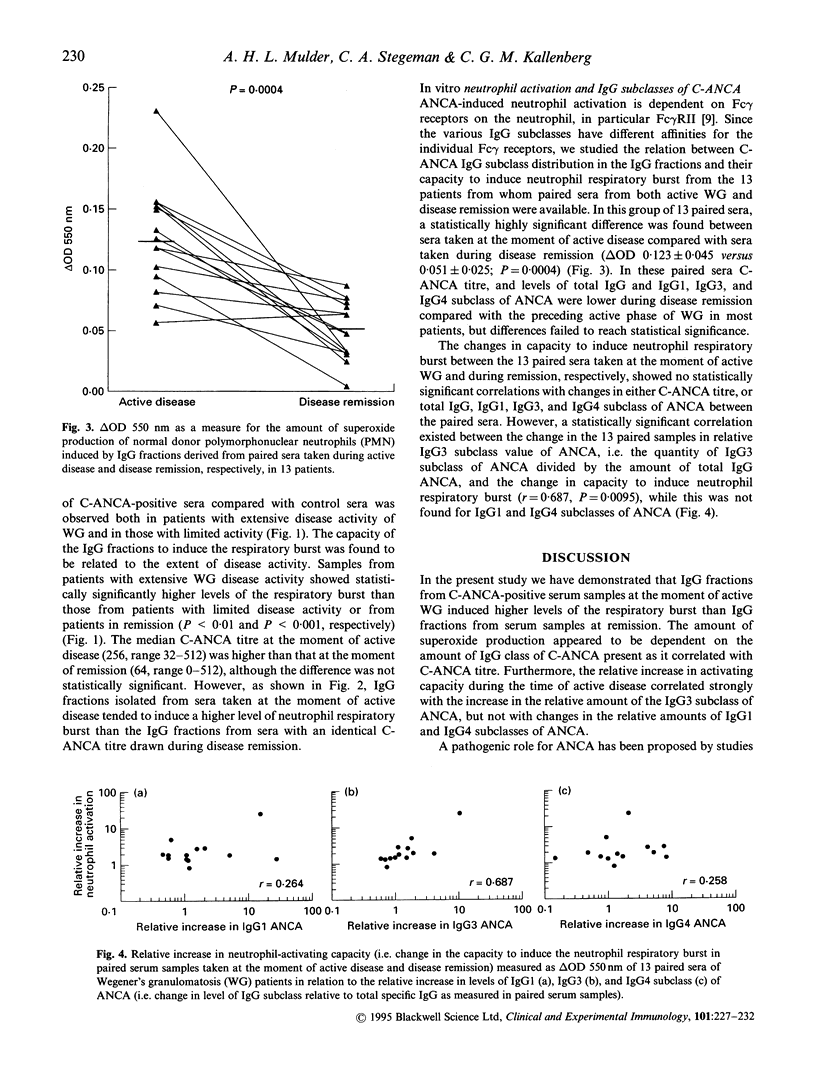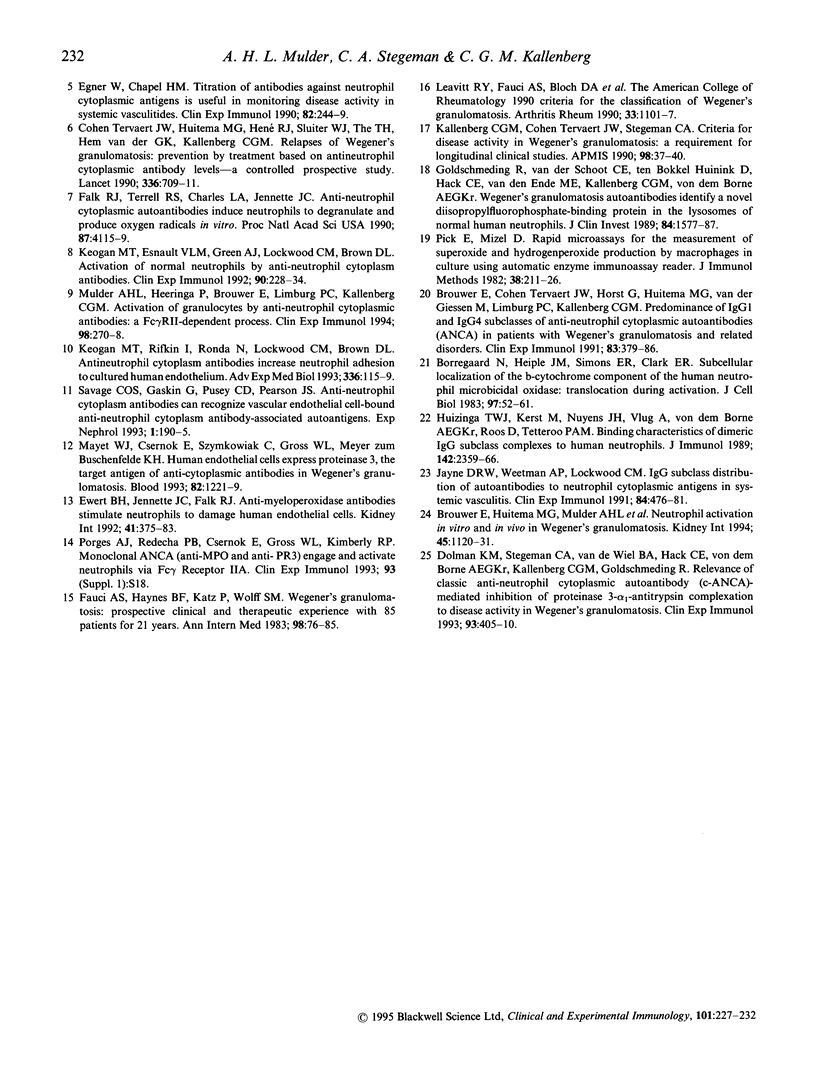Abstract
To study ANCA-induced granulocyte activation in relation to disease activity in Wegener's granulomatosis (WG), serum samples taken from patients with WG at the time of active (n = 17) and inactive (n = 17) disease were analysed for their capacity to activate primed normal donor granulocytes. Compared with control sera (n = 6), the capacity of IgG fractions from patients with WG to induce the respiratory burst was significantly higher (P < 0.0001). Furthermore, the capacity to induce the respiratory burst significantly correlated with ANCA titre (r = 0.499, P = 0.003). IgG fractions from patients with active extensive disease induced the respiratory burst significantly more strongly than IgG fractions from patients with limited disease (n = 7) (P < 0.01) or patients during disease remission (n = 17) (P < 0.001). As ANCA-induced neutrophil activation is Fc-dependent and different IgG subclasses are involved in the interaction with various Fc receptors from neutrophils, we assessed changes in ANCA titre, total IgG and IgG subclass distribution of ANCA during active disease and remission in relation to the neutrophil-activating capacity of ANCA. Changes in capacity to activate granulocytes were related neither to changes in titre nor to changes in levels of total IgG, IgG1, IgG3, or IgG4 subclass of ANCA. However, changes in capacity to induce the respiratory burst were significantly related to changes in the relative amount of the IgG3 subclass of ANCA (P < 0.001), and not to changes in the relative amount of IgG1 or IgG4 subclass of ANCA. These data suggest that the increase in neutrophil-activating capacity of ANCA from inactive to active disease is, at least in part, based on the relative increase of the IgG3 subclass of ANCA that occurs during active disease.
Full text
PDF





Selected References
These references are in PubMed. This may not be the complete list of references from this article.
- Borregaard N., Heiple J. M., Simons E. R., Clark R. A. Subcellular localization of the b-cytochrome component of the human neutrophil microbicidal oxidase: translocation during activation. J Cell Biol. 1983 Jul;97(1):52–61. doi: 10.1083/jcb.97.1.52. [DOI] [PMC free article] [PubMed] [Google Scholar]
- Brouwer E., Huitema M. G., Mulder A. H., Heeringa P., van Goor H., Tervaert J. W., Weening J. J., Kallenberg C. G. Neutrophil activation in vitro and in vivo in Wegener's granulomatosis. Kidney Int. 1994 Apr;45(4):1120–1131. doi: 10.1038/ki.1994.149. [DOI] [PubMed] [Google Scholar]
- Brouwer E., Tervaert J. W., Horst G., Huitema M. G., van der Giessen M., Limburg P. C., Kallenberg C. G. Predominance of IgG1 and IgG4 subclasses of anti-neutrophil cytoplasmic autoantibodies (ANCA) in patients with Wegener's granulomatosis and clinically related disorders. Clin Exp Immunol. 1991 Mar;83(3):379–386. doi: 10.1111/j.1365-2249.1991.tb05647.x. [DOI] [PMC free article] [PubMed] [Google Scholar]
- Dolman K. M., Stegeman C. A., van de Wiel B. A., Hack C. E., von dem Borne A. E., Kallenberg C. G., Goldschmeding R. Relevance of classic anti-neutrophil cytoplasmic autoantibody (C-ANCA)-mediated inhibition of proteinase 3-alpha 1-antitrypsin complexation to disease activity in Wegener's granulomatosis. Clin Exp Immunol. 1993 Sep;93(3):405–410. doi: 10.1111/j.1365-2249.1993.tb08192.x. [DOI] [PMC free article] [PubMed] [Google Scholar]
- Egner W., Chapel H. M. Titration of antibodies against neutrophil cytoplasmic antigens is useful in monitoring disease activity in systemic vasculitides. Clin Exp Immunol. 1990 Nov;82(2):244–249. doi: 10.1111/j.1365-2249.1990.tb05434.x. [DOI] [PMC free article] [PubMed] [Google Scholar]
- Ewert B. H., Jennette J. C., Falk R. J. Anti-myeloperoxidase antibodies stimulate neutrophils to damage human endothelial cells. Kidney Int. 1992 Feb;41(2):375–383. doi: 10.1038/ki.1992.52. [DOI] [PubMed] [Google Scholar]
- Falk R. J., Jennette J. C. Anti-neutrophil cytoplasmic autoantibodies with specificity for myeloperoxidase in patients with systemic vasculitis and idiopathic necrotizing and crescentic glomerulonephritis. N Engl J Med. 1988 Jun 23;318(25):1651–1657. doi: 10.1056/NEJM198806233182504. [DOI] [PubMed] [Google Scholar]
- Falk R. J., Terrell R. S., Charles L. A., Jennette J. C. Anti-neutrophil cytoplasmic autoantibodies induce neutrophils to degranulate and produce oxygen radicals in vitro. Proc Natl Acad Sci U S A. 1990 Jun;87(11):4115–4119. doi: 10.1073/pnas.87.11.4115. [DOI] [PMC free article] [PubMed] [Google Scholar]
- Fauci A. S., Haynes B. F., Katz P., Wolff S. M. Wegener's granulomatosis: prospective clinical and therapeutic experience with 85 patients for 21 years. Ann Intern Med. 1983 Jan;98(1):76–85. doi: 10.7326/0003-4819-98-1-76. [DOI] [PubMed] [Google Scholar]
- Goldschmeding R., van der Schoot C. E., ten Bokkel Huinink D., Hack C. E., van den Ende M. E., Kallenberg C. G., von dem Borne A. E. Wegener's granulomatosis autoantibodies identify a novel diisopropylfluorophosphate-binding protein in the lysosomes of normal human neutrophils. J Clin Invest. 1989 Nov;84(5):1577–1587. doi: 10.1172/JCI114335. [DOI] [PMC free article] [PubMed] [Google Scholar]
- Huizinga T. W., Kerst M., Nuyens J. H., Vlug A., von dem Borne A. E., Roos D., Tetteroo P. A. Binding characteristics of dimeric IgG subclass complexes to human neutrophils. J Immunol. 1989 Apr 1;142(7):2359–2364. [PubMed] [Google Scholar]
- Jayne D. R., Weetman A. P., Lockwood C. M. IgG subclass distribution of autoantibodies to neutrophil cytoplasmic antigens in systemic vasculitis. Clin Exp Immunol. 1991 Jun;84(3):476–481. [PMC free article] [PubMed] [Google Scholar]
- Kallenberg C. G., Tervaert J. W., Stegeman C. A. Criteria for disease activity in Wegener's granulomatosis: a requirement for longitudinal clinical studies. APMIS Suppl. 1990;19:37–39. doi: 10.1111/j.1600-0463.1990.tb05725.x. [DOI] [PubMed] [Google Scholar]
- Keogan M. T., Esnault V. L., Green A. J., Lockwood C. M., Brown D. L. Activation of normal neutrophils by anti-neutrophil cytoplasm antibodies. Clin Exp Immunol. 1992 Nov;90(2):228–234. doi: 10.1111/j.1365-2249.1992.tb07934.x. [DOI] [PMC free article] [PubMed] [Google Scholar]
- Keogan M. T., Rifkin I., Ronda N., Lockwood C. M., Brown D. L. Anti-neutrophil cytoplasm antibodies (ANCA) increase neutrophil adhesion to cultured human endothelium. Adv Exp Med Biol. 1993;336:115–119. doi: 10.1007/978-1-4757-9182-2_19. [DOI] [PubMed] [Google Scholar]
- Leavitt R. Y., Fauci A. S., Bloch D. A., Michel B. A., Hunder G. G., Arend W. P., Calabrese L. H., Fries J. F., Lie J. T., Lightfoot R. W., Jr The American College of Rheumatology 1990 criteria for the classification of Wegener's granulomatosis. Arthritis Rheum. 1990 Aug;33(8):1101–1107. doi: 10.1002/art.1780330807. [DOI] [PubMed] [Google Scholar]
- Mayet W. J., Csernok E., Szymkowiak C., Gross W. L., Meyer zum Büschenfelde K. H. Human endothelial cells express proteinase 3, the target antigen of anticytoplasmic antibodies in Wegener's granulomatosis. Blood. 1993 Aug 15;82(4):1221–1229. [PubMed] [Google Scholar]
- Mulder A. H., Heeringa P., Brouwer E., Limburg P. C., Kallenberg C. G. Activation of granulocytes by anti-neutrophil cytoplasmic antibodies (ANCA): a Fc gamma RII-dependent process. Clin Exp Immunol. 1994 Nov;98(2):270–278. doi: 10.1111/j.1365-2249.1994.tb06137.x. [DOI] [PMC free article] [PubMed] [Google Scholar]
- Nölle B., Specks U., Lüdemann J., Rohrbach M. S., DeRemee R. A., Gross W. L. Anticytoplasmic autoantibodies: their immunodiagnostic value in Wegener granulomatosis. Ann Intern Med. 1989 Jul 1;111(1):28–40. doi: 10.7326/0003-4819-111-1-28. [DOI] [PubMed] [Google Scholar]
- Savage C. O., Gaskin G., Pusey C. D., Pearson J. D. Anti-neutrophil cytoplasm antibodies can recognize vascular endothelial cell-bound anti-neutrophil cytoplasm antibody-associated autoantigens. Exp Nephrol. 1993 May-Jun;1(3):190–195. [PubMed] [Google Scholar]
- Tervaert J. W., Huitema M. G., Hené R. J., Sluiter W. J., The T. H., van der Hem G. K., Kallenberg C. G. Prevention of relapses in Wegener's granulomatosis by treatment based on antineutrophil cytoplasmic antibody titre. Lancet. 1990 Sep 22;336(8717):709–711. doi: 10.1016/0140-6736(90)92205-v. [DOI] [PubMed] [Google Scholar]
- Tervaert J. W., van der Woude F. J., Fauci A. S., Ambrus J. L., Velosa J., Keane W. F., Meijer S., van der Giessen M., van der Hem G. K., The T. H. Association between active Wegener's granulomatosis and anticytoplasmic antibodies. Arch Intern Med. 1989 Nov;149(11):2461–2465. doi: 10.1001/archinte.149.11.2461. [DOI] [PubMed] [Google Scholar]
- van der Woude F. J., Rasmussen N., Lobatto S., Wiik A., Permin H., van Es L. A., van der Giessen M., van der Hem G. K., The T. H. Autoantibodies against neutrophils and monocytes: tool for diagnosis and marker of disease activity in Wegener's granulomatosis. Lancet. 1985 Feb 23;1(8426):425–429. doi: 10.1016/s0140-6736(85)91147-x. [DOI] [PubMed] [Google Scholar]


